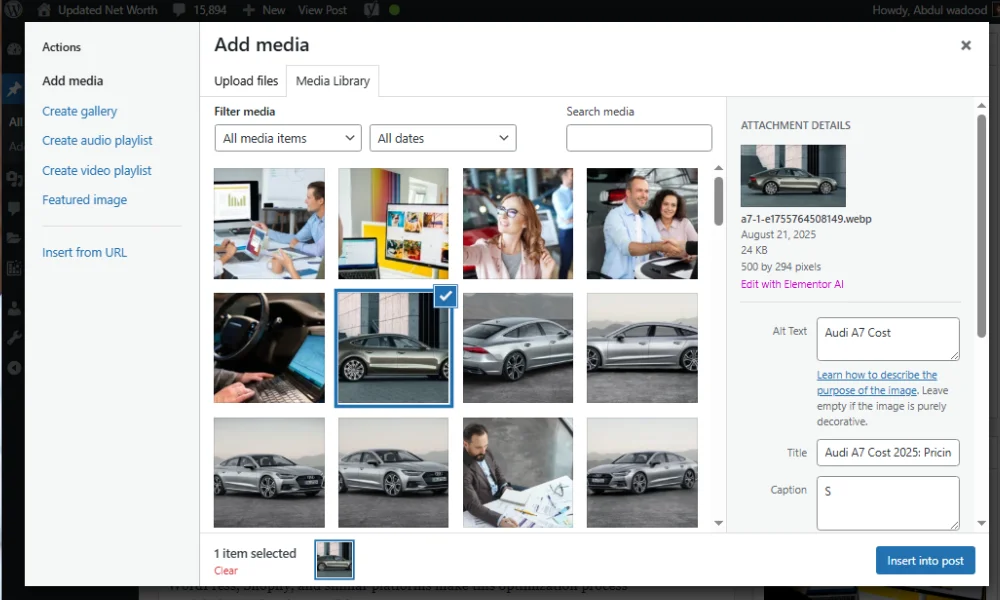Alt attribute SEO is the practice of optimizing HTML alt attributes to improve search engine rankings and website accessibility. This approach helps search engines understand your visual content better while making sites accessible.
What Is Alt Attribute SEO?
Alt attribute SEO involves optimizing alternative text descriptions for web images. This practice helps search engines understand your visual content when they crawl your website pages.
Search engines cannot interpret images like humans do. They depend on alt attributes to understand image content. This text information helps them rank your pages properly in search results.
Why Alt Attribute Matters for Rankings
Alt attributes serve as ranking signals for regular search and image search results. Google uses this information to understand your page’s overall topic and content relevance.
Quality alt text improves your visibility in Google Images searches. It strengthens your page’s topical authority when properly aligned with main keywords and content themes.
How Does Alt Attribute Impact SEO?

Alt attributes provide crucial context that search engines need to properly index your images. Without proper alt text, even highly relevant images remain completely invisible to search algorithms.
When images serve as clickable links, alt text functions as anchor text. This affects how link equity flows through your site and directly impacts your internal linking strategy.
Image SEO Optimization with Alt Text
Google considers alt text the most important factor for image search rankings. Well-written alt attributes significantly increase your chances of appearing in relevant image searches.
Alternative text helps establish content relevance beyond just written text. It reinforces your page’s main topics through visual elements, creating stronger topical signals for search engines.
Alt Attribute Best Practices for SEO
Write Descriptive Alt Text Content
Replace vague descriptions like “product image” with specific details. Use phrases like “black leather Oxford shoes with brogue detailing” for better context and user understanding.
Specific descriptions provide real value to both users and search engines. They help screen reader users understand your content while giving search engines much better contextual information.
Keep Alt Attributes Concise
Limit alt text to 125 characters or fewer for maximum compatibility across platforms. This constraint forces you to focus on the most important and relevant visual elements only.
Concise descriptions work better across all devices and assistive technologies. They also ensure your complete message gets delivered without being cut off by character limits.
Include Keywords in Alt Text Naturally
Use one or two relevant keywords within your alt text naturally. Avoid keyword stuffing practices, which can hurt both user experience and your overall search engine rankings.
Natural keyword integration maintains readability while supporting your SEO goals. Focus on making the description genuinely helpful first, then optimise carefully for target keywords.
How to Write Effective Alt Attributes?
Focus on Essential Information
Describe the most important visual elements that directly support your content’s meaning. Prioritize details that relate closely to your page’s main purpose and topic focus.
Consider what crucial information a user would lose if they couldn’t see the image. This approach helps you identify the most essential elements to include in your alt text description.
Match Your Alt Text Context
Evaluate how each image supports your overall content strategy and messaging. Alt text should reinforce your main messages rather than describing random or irrelevant visual details.
The same image might need different alt text depending on its specific context. A dog photo might be described differently on a pet care site versus a professional photography blog.
Use Action Language in Alt Attributes
Describe what’s happening in dynamic images using active verbs and action words. This creates more engaging descriptions that better capture the image’s purpose and meaning.
Action-oriented language works especially well for instructional and educational content. It helps users understand processes and procedures much more clearly and effectively.
Common Alt Attribute SEO Mistakes
Keyword Stuffing in Alt Text
Avoid cramming multiple keywords into your alt attributes unnecessarily. This practice triggers search engine penalties and creates poor user experiences across your website.
Focus on one or two relevant keywords maximum for each image. Make sure they fit naturally within your descriptive text rather than forcing them in awkwardly or unnaturally.
Missing Alt Attributes
Empty alt text represents a major missed opportunity for both SEO and accessibility benefits. Every meaningful image should include proper alternative text descriptions.
Search engines cannot understand blank alt attributes at all. Users with screen readers also miss important contextual information when alt text is completely missing from images.
Generic Alt Text Descriptions
Vague phrases like “photo” or “image” provide no real value to users. They waste your limited character count without offering any useful or meaningful information.
Generic descriptions frustrate both users and search engines alike. Invest time in creating specific, helpful descriptions that add genuine value to your content and user experience.
Which Images Need Alt Attributes?
Content Images with Alt Text
All images that convey important information require descriptive alt text. This includes product photos, screenshots, infographics, charts, and instructional images throughout your site.
These images directly support your content’s core meaning and purpose. Without proper alt text, important information becomes completely inaccessible to many users and search engines.
Functional Images Alt Attributes
Images serving as buttons or clickable links need alt text describing their function. Focus on explaining what happens when users interact with these functional elements.
Functional alt text should explain the specific action rather than visual appearance. Use clear phrases like “Submit contact form” instead of vague descriptions like “green button.”
Decorative Images Alt Text
Purely decorative images should have empty alt attributes for optimal accessibility. This prevents screen readers from announcing unnecessary visual details to users.
Use alt=”” for decorative elements that don’t add informational value to your content. This keeps the focus on meaningful content and improves the overall user experience.
Alt Attribute Technical Implementation

HTML Alt Attribute Setup
Use the standard HTML alt attribute format: <img src="image.jpg" alt="descriptive text">. This basic implementation works effectively across all modern browsers and platforms.
Proper HTML structure ensures full compatibility with assistive technologies. It also helps search engines process and understand your alt text correctly for better rankings.
CMS Alt Text Platforms
Most content management systems provide dedicated alt text fields during image upload. WordPress, Shopify, and similar platforms make this optimization process straightforward and accessible.
Take full advantage of your CMS’s built-in features for alt text management. This approach ensures consistent implementation and optimization across your entire website structure.
Advanced Alt Attribute Strategies
Dynamic Alt Text Generation
E-commerce sites can generate alt text automatically based on product attributes and data. This ensures consistency while maintaining uniqueness across large product inventories.
Dynamic generation works exceptionally well for product catalogs with similar items. It saves significant time while maintaining high-quality descriptions across thousands of products.
Complex Images Alt Attributes
Charts and diagrams need both concise alt text and longer detailed descriptions. Combine brief alt attributes with comprehensive explanations in nearby text or caption areas.
Complex visuals require more comprehensive description strategies than simple images. Consider using additional HTML elements or detailed caption text to provide complete contextual information.
Measuring Alt Attribute SEO Success

Track Alt Text Performance
Monitor image search rankings through Google Search Console’s performance reports. Filter data specifically to see how your images perform in search results and image searches.
Regular monitoring helps identify new opportunities for improvement and optimization. Track both impressions and click-through rates for comprehensive insights into your image performance.
Alt Attribute Accessibility Audits
Use accessibility tools like WAVE or Axe to find missing alt attributes across your site. Regular audits ensure ongoing compliance and maintain high-quality user experience standards.
Automated tools catch technical issues quickly and efficiently across large sites. However, manual review ensures alt text quality, relevance, and proper optimization for your specific content.
Conclusion
Alt attribute SEO delivers significant benefits for search visibility and user accessibility. Proper implementation requires carefully balancing descriptive content with strategic keyword optimization.
Start auditing your current images and apply these proven strategies systematically. Well-optimised alt attributes will improve both your search rankings and user experience across your website










